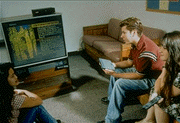I have seen the future and it works (sort of).
WEB TV and Quicktimes on The Thing.

On one end of the web universe you have the marketeers pushing for larger audiences. Their goal: wire every household in the U.S. with cheap set top boxes that hook you up to the internet automatically. On the other you have artists trying to build a new language and aesthetic through experimentation. Web TV promises to make surfing the web a family activity just like watching television. The hardware and software have been licensed by Sony and Phillips. Both companies plan to ship set top boxes and TV's that have web capabilities September first. Of course along with the hardware, Web TV has an online service similar to AOL that gives you e-mail, local news, chat, etc.. Their goal is for all of the world to go to places like The Simpson's home page or The Friends tv show website. Oh boy! I can hardly wait. The up side to all this marketing frenzy is the potential for artists to reach really large audiences. This brings us to the "content" side of the discussion and interjects a little reality into corporate marketing utopia. Broad bandwidth is still just a gleam in the eye of Viacom and even with the 33.6 kbs modem in Web TV you ain't gonna get full motion video. The artists who have put up quicktimes on The Thing know this and work with the limitations. Most files are small and take maybe 3 minutes to load onto your disk cache. The emphasis is on economy of means.
Eyes Open is a series of photo stills of a head (David Byrne) revolving. The work is simple, hypnotic and has a machine like feel. I'm reminded of Bruce Nauman's video of a man spinning but all at once Nauman's work is clunky and old fashioned compared to this piece. Buddha Brand Condom is an animated Indian type print of a Buddha. In its hand is a blue square which I assume is the condom. The blue square swirls and becomes the same Buddha in an endless cycle. The piece is stunning in it's spareness and wit. Both works are by by Steve Pollack and Renate Sturmer. Throwing Four Balls, the repurposed video by John Baldessari executed by David Platzker is interesting in an art historical way but is rather flat. It's main feature is bringing esoterica to the masses, (in this instance me, since I've never seen the piece). The high point of Thing Quicktimes is Wolfgang Staehle's "New" which features a group of cows in a pasture shot from various angles their heads waving back and forth in a synthetic loop while mooing the word new. This is a clever jab at the marketing of newness and harkens back to any number of cliched TV commercials of years past. The piece is a thumb in eye and shows Staehle's wry sense of humor. Michael Smiths' "Mike" is an extension of his dumb everyman video-performances. This is a faux B&W commercial where Mike hold up a shoe. The sound track says, "Mike makes the ordinary extraordinary". Well ok, this treads familiar turf and is about as exciting as Prozac. Mix by Roth/Stauffenberg is a series of stills and black screens. The images are of an outdoor wedding, a svelte women's body diving into a sparkling ocean, the bride dancing with her father, the New York skyline shot from a helicopter, flowers and a child playing a drum. These are all the standard icons of commercial photography. The work is cool and allows the viewers to draw their own conclusions. "Phillip and Beaver" by Huber/Pocock is a simple comparison. two screens open, one shows a man swimming and the other a beaver swimming. This work conveys the basic pleasure of motion and is just right. "Emperor Franz Joseph" is an ambitious attempt by Ursula Endlicher to present performance art on the web and it works. We see a women with a military helmet late Habsburg style, a handlebar moustache, and an accordion play some Abba tune. The audience applauds. Here the idea of a "clip" gives some sense of the actual performance and seems much better suited to the task than the standard stills one is used to in gallery presentations. As for the rest of the Quicktimes the files were a little too large for me to wait for the download.
This is the challenge of low bandwidth that most of the artists in the Quicktime section have addressed with innovative results. The beginning of a networked multimedia aesthetic will not happen on the Time Warner website no matter what the corporate suits think.
Email: ThingReviews
To post a response fill out the following form and click the "Submit" button. Or go back...
Scroll down to read messages.
murph -- murph@artnetweb.com
Responds:
I like to think that Baldessari made "Throwing Four Balls" in QuickTime rather than video and it was just a folding of time that the technology didn't exist until now. It is the "earlier" video version that would then be "repurposed." The cows, however, are timeless...
Nino Rodriguez -- nino@pobox.com
Responds:
Check out "Who is on the Edge?"
